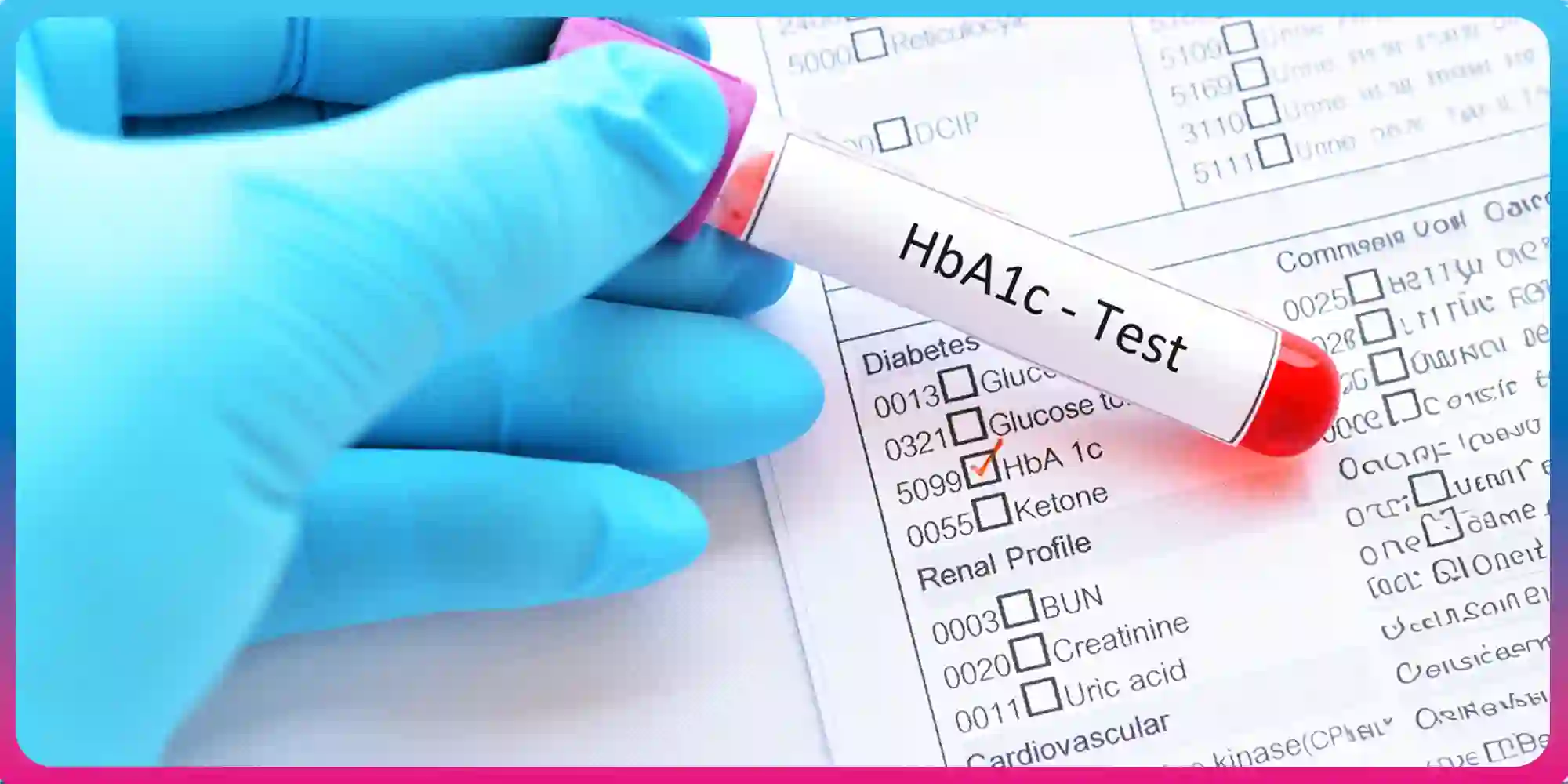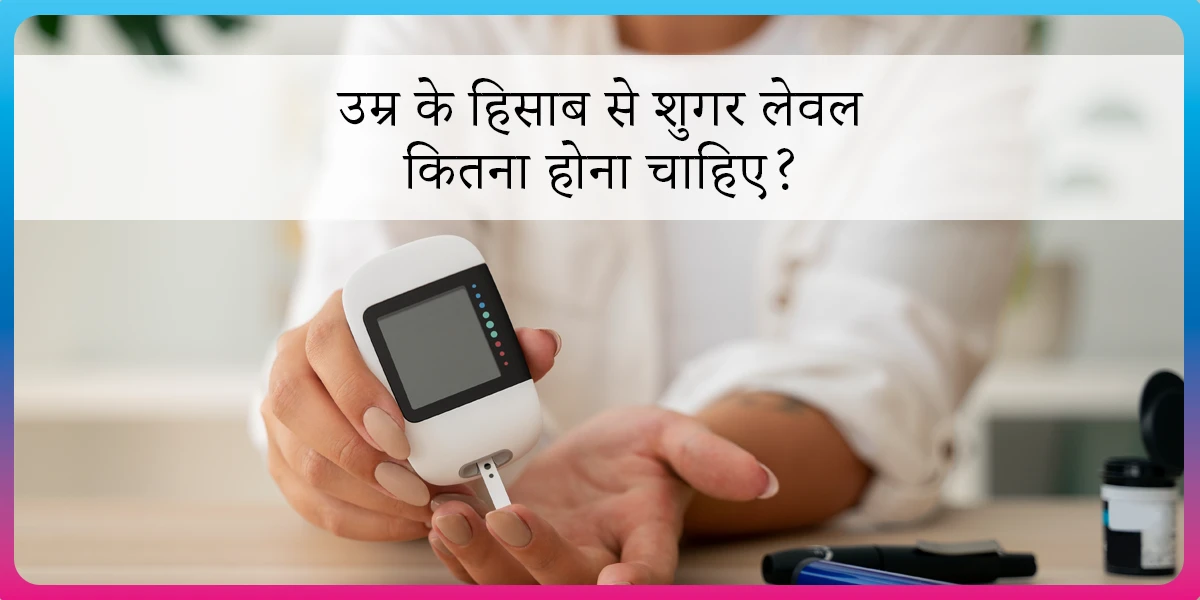HbA1c Test Guide: Normal Range, A1c Levels, and Significance

If you or a loved one has been diagnosed with type 2 diabetes or prediabetes, you have probably come across the term HbA1c. HbA1c refers to Hemoglobin A1c, a vital component of red blood cells that binds with glucose.
When blood sugar levels are elevated, HbA1c levels increase as well, leading to a measurable change in its concentration within the blood. In this article, we’ll break down everything you need to know about HbA1c, how it’s measured, what the results mean, and even some handy tips to keep those levels in check.
Don’t worry; we’ll keep it simple and easy to understand.
What is the HbA1c Test, and Why is it Done?
HbA1c test full form – Hemoglobin A1c is a test that helps us understand how well your blood sugar has been doing over the past few months (2-3 months). It’s like a little report card for your sugar levels. You might be wondering why this test is so crucial.
Well, HbA1c is the test that not only helps diagnose diabetes but also helps your doctor figure out if your diabetes management plan is working effectively. It gives you a big-picture view of how your blood sugar has been doing, not just a quick snapshot.
But that’s not all! By monitoring your HbA1c levels, you can also reduce the risk of diabetes-related complications. It’s like catching a problem before it gets too serious.
Understanding the A1c Test
Your blood contains a type of sugar known as glucose. Over time, too much glucose in your blood sticks to hemoglobin, which is a part of your red blood cells. The A1c test calculates the amount of glucose that is attached to hemoglobin.
The A1c test gives an average of your blood sugar levels over the last 3 months because red blood cells, where sugar sticks, live for about that long. If your blood sugar has been high lately, your A1c result will also be high.
Why Do You Need an HbA1c Test?
You might need an HbA1c test to check for diabetes or prediabetes because:
- It’s suggested if you’re 45 or older. If everything looks okay, do the test again every 3 years.
- If the test says you might be getting diabetes soon (prediabetes), you should test every 1 to 2 years. Talk to your doctor about how often to test and how to lower your diabetes risk.
- If you find out you have diabetes, you need this test at least twice a year to keep an eye on it.
Even if you’re younger than 45, you might need this test if you:
- Are likely to get diabetes because you have prediabetes, are overweight, or have a family history of diabetes.
- Have high blood pressure, high cholesterol, heart disease, or a stroke.
- Have a sedentary lifestyle,
- Had diabetes during pregnancy.
- Have polycystic ovarian syndrome (PCOS).
Diabetes Reversal
Calculator
To know your chances of Diabetes reversal, take the Diabetes Reversal Test
You might also need an HbA1c test if you show signs of diabetes like:
- Being really thirsty/hungry more often
- Going to the bathroom to pee a lot
- Losing weight without trying
- Blurry vision
- Feeling numb or tingling in your hands or feet
- Feeling tired
- Having dry skin
- Having cuts that heal slowly
- Getting sick more often than usual
Hemoglobin A1c (HbA1c) and Average Blood Sugar Chart

What is the Normal Range for HbA1c?
Knowing your HbA1c levels helps you understand your blood sugar and diabetes risk. Here’s an easy explanation of what these numbers mean:
| Category | HbA1c Levels | Description |
| Normal Range | 4% – 5.6% | Considered normal for people without diabetes. |
| Prediabetes | 5.7% – 6.4% | Higher than normal blood sugar levels, increase the risk of developing type 2 diabetes without lifestyle changes. |
| Diabetes | 6.5% or higher | Indicates consistently elevated blood sugar levels, requiring medical management to prevent diabetes complications. |
What is the Normal Range for HbA1c by Age?
The normal range for HbA1c typically varies by age for adults and children.
| Age Group | Normal HbA1c Range |
| Adults (20 years and older) | Below 5.7% |
| Children (Under 6 years) | Below 8.5% |
| Children (6 to 12 years) | Below 8% |
| Teens (13 to 19 years) | Below 7.5% |
Why Do Normal HbA1c Ranges Vary by Age?
The reason why normal HbA1c levels might vary with age isn’t fully agreed upon by diabetes experts. It’s likely due to several reasons, including differences in race and the individual needs of each person with diabetes.
This means there’s no single HbA1c target that works for everyone. What we do know is that HbA1c levels tend to go up as people age, even in those without diabetes.
This suggests that age plays a role in determining what a “normal” HbA1c level is.
Reduced HbA1c by HALF in 6 months


6.6%
Happy members
EMI
Guarantee
4.8/5
Diabetes Prime Program
HbA1c and Pregnancy
The HbA1c test during pregnancy is an important tool for monitoring blood sugar levels in expectant mothers, especially those with pre-existing diabetes or gestational diabetes.
This test measures the average blood sugar levels over the past 2 to 3 months by assessing the amount of glucose attached to hemoglobin in the blood.
Importance of HbA1c Testing in Pregnancy
Blood Sugar Control: Maintaining optimal blood sugar levels is crucial during pregnancy to prevent complications for both the mother and the baby.
- Risk Assessment: It helps in assessing the risk of gestational diabetes or managing pre-existing diabetes.
- Health Monitoring: Regular HbA1c testing aids in adjusting treatment plans to ensure the health and well-being of both mother and child.
Normal range of HbA1c levels during pregnancy
| Pregnancy Stage | Normal HbA1c Range |
| Pre-pregnancy | Less than 6.5% |
| First trimester | 6.0% or lower |
| Second trimester | 5.7% to 6.0% |
| Third trimester | 5.7% to 6.0% |
How Does HbA1c Differ from Regular Blood Sugar Tests?
Unlike regular blood sugar tests that provide a snapshot of current glucose levels, HbA1c reflects an average of blood sugar levels over the past two to three months. This makes HbA1c testing a valuable tool for assessing long-term sugar control.
| Aspect | HbA1c Test | Finger-Prick Test |
| What It Shows | Your average blood sugar level over the last 2-3 months | Your blood sugar level right now |
| How Often | Every 3-6 months | Many times a day, usually 2 to 10 times |
| Who Needs It | Everyone with diabetes | People with diabetes, especially if they use certain medicines |
| How It’s Done | Blood is taken from your arm or finger | A small drop of blood is taken from your finger |
| Who Does It | A doctor or nurse, but you can also do it yourself with a kit
(but you can’t get the kit for free) |
You can do it yourself with a kit |
| Why It’s Used | To check how well you’re managing your diabetes, to see if you have diabetes, or to see if you might get type 2 diabetes | To check your blood sugar level at that moment, mostly used by people with diabetes |
Importance of Maintaining HbA1c Levels
Maintaining optimal HbA1c levels is crucial for people with diabetes as:
- It directly correlates to the risk of developing diabetes-related complications.
- It is also helpful in the diagnosis of diabetes.
Who needs an HbA1c test?
- If you have been diagnosed with type 2 diabetes or prediabetes, your doctor will suggest you do this test regularly (every 2-3 months), or if you are planning to have a baby, your doctor may refer to this test as a precautionary health check.
You may also be asked to take this test as a screening test for diabetes if you:
- Are overweight or obese
- Have a history of heart disease
- Have high blood pressure or hypertension
- Have a sedentary lifestyle
The Process of HbA1c Testing
1. How HbA1c levels are measured
The test is conducted in a lab by collecting venous blood samples, which does not require fasting.
2. Frequency of HbA1c testing
Frequency depends upon your health care provider and your diabetes control, but it is recommended to have HbA1c tested at least every three to six months for most people with diabetes.
3. Understanding the results classification
- The normal range below 5.7%
- Prediabetes between 5.7% and 6.4%
- Diabetes mellitus 6.5% or higher
- For people who have diabetes, the ideal HbA1c level should be <7 or below.
Remember, these results are not something to be scared of; they are valuable insights that help you and your healthcare provider understand your diabetes better and make necessary adjustments to your treatment plan.
Factors That Can Affect HbA1c Levels
1. Blood glucose variability
Fluctuations in blood glucose levels can impact HbA1c results. Consistent blood sugar monitoring and adherence to diabetes management strategies can help stabilize HbA1c levels.
2. Anemia and Hemoglobin disorders
Certain medical conditions, such as anemia and hemoglobin disorders characterised by low or high Hb, can influence HbA1c values. So healthcare providers need to consider such factors while interpreting test results.
3. Medications and Supplements
Some medications and supplements may affect HbA1c levels. Individuals should inform their healthcare providers about all the medications and supplements they are taking to ensure accurate interpretation of test results.
4. Lifestyle and Diet
Lifestyle factors, including diet, portion control, physical activities such as exercise and yoga, and stress management, can significantly manage HbA1c levels. Making healthier lifestyle choices can positively impact HbA1c results.
NOTE: HbA1c is not recommended for people with hemoglobinopathies (abnormal haemoglobin) like sickle cell anemia, thalassemia, and Hb E disease. Instead, they are advised to use self-monitoring of blood glucose (SMBG) or fructosamine to monitor their sugar control.
What If I Have a High HbA1c?
If you have a high HbA1c, it means that you have poor blood sugar control. This can increase your risk of developing complications related to diabetes. Here are some steps you can take on how to lower your HbA1c levels:
- Increase physical activity
- Adopt a balanced and healthy eating plan
- Quit smoking
- Timely review of your medication
- Opt for a scientifically proven program
Benefits of Reducing HbA1c
Lowering HbA1c levels in people with diabetes can provide several benefits, including:
- Reduced risk of microvascular complications
- Reduced risk of cardiovascular disease
- Improved overall health
- Better quality of life
What should be the A1c Goal?
- Aim to keep A1c below 7% for most people with diabetes.
- This helps manage diabetes and lowers the risk of related issues.
- A1c targets can vary based on personal health, age, and other factors.
- Always consult with your healthcare provider for a personalized A1c goal.
Tips for Maintaining Healthy HbA1c Levels
Below are some tips to help you maintain healthy HbA1c levels:
1. Lifestyle Modification
2. Regular Blood Sugar Monitoring: Self-Monitoring of Blood Glucose (SMBG) or Continuous Glucose Monitoring (CGM)
3. Regular Monitoring of HbA1c
4. Following Treatment as Advised
5. Regular Visits to Diabetologist to review your medication and treatment plan
6. Know Your Target HbA1c and Its Benefits
Fitterfly offers personalised diabetes management, including a diet plan, stress management, and exercise.
FitterTake
In simple terms, keeping an eye on your HbA1c levels and making good choices for your health can really help you handle diabetes better.
You can try following tips to maintain healthy HbA1c levels:
- Eat balanced meals with plenty of veggies.
- Stay active – try walking, swimming, or biking.
- Check blood sugar as recommended.
- Manage stress with activities like yoga or meditation.
- Ensure you get enough sleep each night.
By picking healthier habits and making your diabetes plan fit your own life, you can make a shift from being diabetic to pre-diabetic. This will allow you to personalize your management instead of following a generic plan. And will also help you tackle other factors that affect blood sugar levels, such as sleep and stress.
At Fitterfly, we offer a personalised plan for people with diabetes, designed by our expert dietitians, physiotherapists and psychologists, who help you manage your diabetes and HbA1c level like a pro.
All you need to do is opt for our Diabetes Care Plan, which offers all the tests, including HbA1c.
If you want to know more, then you can sign up for our program, or you can just give a missed call at 08068507599, to know more.
This blog provides general information for educational and informational purposes only and shouldn't be seen as professional advice.
Frequently Asked Questions
What is the normal range for HbA1c?
The normal range for HbA1c is usually below 5.7%. If your HbA1c falls between 5.7% and 6.4%, it may indicate prediabetes. A level of 6.5% or higher generally indicates diabetes.
HbA1c: When to test?
It is recommended to have an HbA1c test at least twice a year if you have diabetes and are meeting your treatment goals. If your diabetes management plan has changed or if your blood sugar levels are not well-controlled, your healthcare provider may suggest more frequent testing.
HbA1c test and finger-prick test – what is the difference?
The HbA1c test measures the average blood sugar levels over the past few months, while the finger-prick test (also known as blood glucose testing) provides a snapshot of your current blood sugar levels.
What is it used for?
The HbA1c test is used to assess long-term (2-3 months) blood sugar control, identify diabetes, and monitor the effectiveness of diabetes management plans.
Why is the HbA1c test done?
The HbA1c test is done to provide a comprehensive view of how well your blood sugar has been managed over time, helping healthcare providers make informed decisions about your diabetes treatment.
How to Prepare for Your A1C Test?
Generally, no special preparation is needed for the HbA1c test. You can have it at any time of the day and without fasting.
Are there any risks to the HbA1c test?
The HbA1c test is a simple blood test with minimal risks. Some people may experience minor bruising or discomfort at the site where the blood is drawn.
What do the results mean?
The HbA1c test results as a percentage. Normal levels mean good blood sugar control, while higher levels may indicate the need for adjustments to your diabetes management plan.
How is the HbA1c test done?
The HbA1c test is a simple blood draw from a vein, usually in your arm. The blood sample is then sent to a lab for analysis.
What is the HbA1c test procedure time?
The HbA1c test procedure usually takes just a few minutes to draw the blood, and the results are typically available within a few days.
How often should the HbA1c test be conducted?
The HbA1c test is recommended every three to six months to monitor blood sugar control and make necessary adjustments for people with diabetes.
Who should take the HbA1c test?
People with diabetes or those at risk of developing diabetes should consider taking the HbA1c test to assess their blood sugar control.
What Can Affect Your A1C Result?
Several factors can affect your HbA1c result, including blood glucose variability, anemia, certain medications, lifestyle choices, and dietary habits.
A1C Goal or target for all categories?
The target HbA1c level may vary depending on the individual's age, overall health, and diabetes management plan. Your healthcare provider will determine the appropriate target for you.
Why is it important to monitor HbA1c?
Regularly monitoring HbA1c levels is vital for diabetes management as it helps track blood sugar control over time and reduces the risk of complications.
Why is the HbA1c test done every 3 months?
The HbA1c test is done every three months because it reflects the average blood sugar levels over the past two to three months, providing valuable insights into diabetes management.
What are the reasons for fluctuations in HbA1c normal range?
Fluctuations in the HbA1c normal range can occur due to various factors, such as changes in diet, medication, physical activity, stress, and illness.
What is the HbA1c Chart?
The HbA1c chart is a reference tool that shows the relationship between HbA1c levels and average blood sugar levels.
What are the causes of high or low HbA1c?
High HbA1c levels can be caused by poor blood sugar control, while low levels can occur due to factors like anemia or certain medical conditions.
Does low hemoglobin affect A1C?
Yes, low hemoglobin levels can affect the accuracy of the HbA1c test, leading to potential misinterpretation of the results.
What is the haemoglobin A1c Conversion Chart?
The Haemoglobin A1c Conversion Chart provides a way to convert HbA1c values from percentage to millimoles per mole (mmol/mol) and vice versa.
What are the natural ways to bring the normal range of HbA1c?
Natural ways to bring HbA1c within the normal range include regular exercise, balanced diet, stress management, and adequate sleep.
What is normal HbA1c by age?
Normal HbA1c levels can vary by age, and your healthcare provider will consider your age and overall health when interpreting the results.
What are the symptoms of high HbA1c?
High HbA1c levels may lead to symptoms such as increased thirst, frequent urination, fatigue, and blurred vision.
What is a normal A1c level for a woman?
A normal A1c level for a woman is usually below 5.7%, indicating good blood sugar control.
What is the normal range of HbA1c during pregnancy?
During pregnancy, the target HbA1c level may be different, and your healthcare provider will provide specific guidelines to maintain optimal blood sugar levels.
How much is the cost of HbA1c test?
The cost of the HbA1c test may vary depending on the healthcare provider, location, and insurance coverage. Its usual range is from Rs 300 to Rs 600. However, some labs may charge extra for the home collection.
What is a dangerous level of A1c?
Typically, a healthy HbA1c level falls below 5.7%. Levels ranging from 5.7% to 6.4% suggest a condition called prediabetes. If your HbA1c is above 6.5%, it usually means diabetes. Levels reaching 8.5% to 9% or higher are considered very high and suggest that your blood sugar levels may be dangerously elevated, requiring urgent care.























